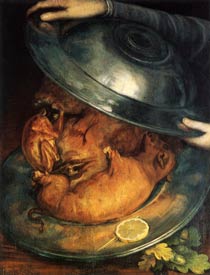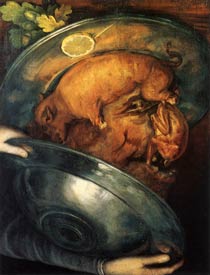Italian, (ca.1527-1593)
-
The Cook
- (c. 1570), oil on panel
- 20.7 x 16 in. (52.5 x 41 cm.)
- National Museum, Stockholm
-
Editor’s Note:
The above is a ‘double meaning’ image. If the left image above is inverted it changes from the image of a platter of roast suckling pig and fowls to the image of a man’s head – the cook who prepared the platter.
Arcimboldo created a great number of these ‘double meaning’ and allegorical paintings. Today, most seem to be abstract portraits or the odd imaginings of the artist. But in Arcimboldo’s time they were seen to be full of easily recognizable allegorical references or double images that modern viewers likely don’t recognize or appreciate.
“The Cook” above is of the double image variety. It is a visual pun on a platter of delicious roast suckling pig and fowls and, flipped, the image of the rather rough-looking cook who prepared the platter. Other paintings are more allegorical, such as Arcimboldo’s portraits of the seasons, assembled with their associated fruits, nuts, vegetables, and related images, and other portraits such as a Librarian made from books, a Jurist from fish and meat, Water from aquatic animals, and Emperor Rudolf II, portrayed by fruits from all four seasons and representing harmony.
About the Artist
Giuseppe Arcimboldo, Italian, (ca.1527 – 1593) [also spelled Josephus, Joseph or Josepho / Arcimboldi or Arcimboldus]. Arcimboldo was a painter, window and tapestry designer and organizer of parties, processions, celebrations and festivals. He also did theatrical design, and designed architecture.
Arcimboldo is probably best known for his imaginative painted portrait heads which he created entirely from images of such objects as fruits, meats, vegetables, flowers and books. He painted representations of these objects on the canvas arranged in such a way that the composite formed a recognizable likeness of the portrait subject.
In 1562 Arcimboldo accepted a position at the Hapsburg imperial court of Ferdinand I, staying on at court under Maximilian II and Rudolf II, serving for twenty-five years as Court Artist and celebration planner. During this time he did the paintings he is most remembered for today.


